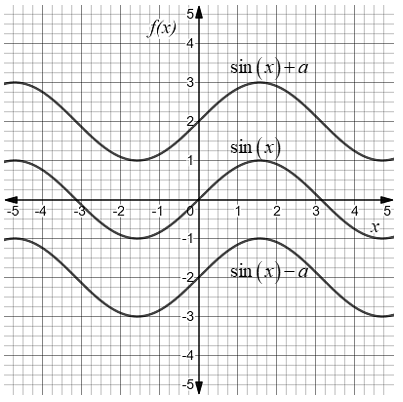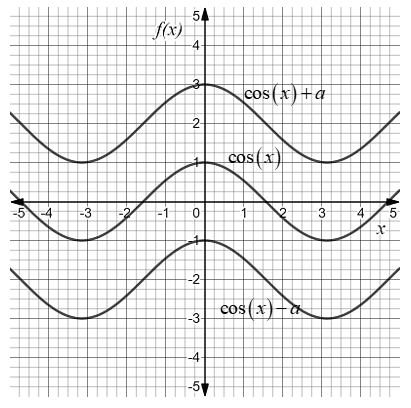Question
Question: How do you identify the vertical and horizontal translations of sine and cosine from a graph and an ...
How do you identify the vertical and horizontal translations of sine and cosine from a graph and an equation?
Solution
For the function y=f(x), the vertical translation is described by the equation y=f(x)+a and horizontal translation is described by the equation y=f(x−a). the vertical translation is described by the equation y=f(x)+a such that if a is greater than zero then the shift in the graph is upward from the original and if a is less than zero then the shift in the graph is downward from the original. the horizontal translation is described by the equation y=f(x−a) such that if a is greater than zero then the shift in the graph is toward right from the original and if a is less than zero then the shift in the graph is toward left from the original.
Complete step by step solution:
Consider the sine function as y=sinx and the cosine function as y=cosx.
It is known that for a function y=f(x), the vertical translation is described by the equation y=f(x)+a such that if a is greater than zero then the shift in the graph is upward from the original and if a is less than zero then the shift in the graph is downward from the original.

Therefore vertical translation of a sine function is written as y=sinx+a and the vertical translation of a cosine function is written as y=cosx+a. Where a cannot be zero.

Thus, if we are able to write the sin function in the form y=sinx+a and the cosine function in the form y=cosx+a where in both cases a=0 then it represents vertical translation in both trigonometric functions from the original.
In the graph, if sine functions or cosine functions wave is not symmetric to x-axis then there is a vertical shift in the graph from the original.
It is known that for a function y=f(x), the horizontal translation is described by the equation y=f(x−a) such that if a is greater than zero then the shift in the graph is toward right from the original and if a is less than zero then the shift in the graph is toward left from the original.
Therefore horizontal translation of a sine function is written as y=sin(x−a) and the horizontal translation of a cosine function is written as y=cos(x−a). Where a cannot be zero.
Thus, if we are able to write the sin function in the form y=sin(x−a) and the cosine function in the form y=cos(x−a) where in both cases a=0 then it represents horizontal translation in both trigonometric functions from the original.
In the graph, if sine functions or cosine functions wave is not symmetric to y-axis then there is a horizontal shift in the graph from the original.
Note: For horizontal shift, the function is y=f(x−a) and for vertical shift, the function is y=f(x)+a if the original function is y=f(x). The horizontal translation of a sine function is written as y=sin(x−a) and the horizontal translation of a cosine function is written as y=cos(x−a). Where a cannot be zero. The vertical translation of a sine function is written as y=sinx+a and the vertical translation of a cosine function is written as y=cosx+a. Where a cannot be zero.
